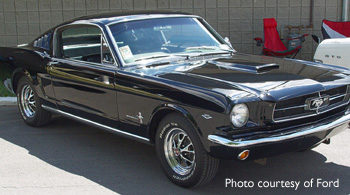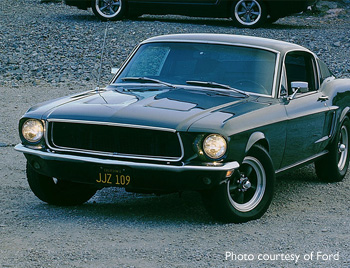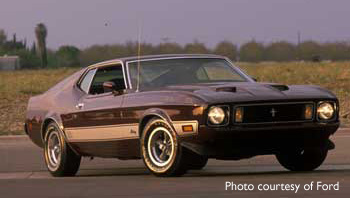Ford Mustang
FIRST GENERATION FORD MUSTANG: 1964 - 1973
The first generation of Ford Mustangs was produced from 1964 to 1973. Assembled in Dearborn, San Jose California and Michigan, Ford introduced three body styles for the soon-to-be classic luxury car – 2-door coupe, 2-door convertible and 2-door fastback. With a curb weight of 2,570 lb for the six-cylinder engines and 3,000 lb for the V8-equipped Mustangs, all models were designed 181.6 inches long and 68.2 inches wide.
The engines for the first generation Mustang included 170 cu in Thriftpower I6, 200 cu in Thriftpower I6, 250 cu in Thriftpower I6, 260 cu in Windsor V8, 289 cu in Windsor V8, 302 cu in Windsor V8, 302 cu in Boss 302 V8, 351 cu in Windsor V8, 351 cu in Cleveland V8, 390 cu in FE V8, 427 cu in FE V8, 428 cu in FE V8 and 429 cu in Cobra Jet V8. They were equipped with 3-speed manual, 4-speed manual, 2-speed automatic and 3-speed automatic transmissions.
When Donald N. Frey, Ford product manager, conceived the idea of the Mustang, the prototype was a two-seat, mid-engine roadster, which would then be remodeled as 4-seat by John Oros and David Ash. To cut down production costs, the Ford Lincoln-Mercury Division used simple components on the Mustang. The drivetrain, suspension and chassis all came from the Fairlane and Falcon. Car lovers fled to buy hardtop Mustangs during its first production, but durability problems arise, which led to development of the convertibles.
Majority of the Mustangs components came from the Falcon. Even the overall length was identical, but the Mustang’s wheelbase of 108 inches was slightly shorter. However, the body of the Mustang was entirely in another league – sporting a wider track, shorter wheelbase and lowered seats. Plus, Mustang was the first models to include an innovate structural torque box, which helped in stiffening Mustang’s overall built and gave way to better handling.
 1965 Mustang
1965 Mustang
The early 1965 Mustangs were priced at $2,368 for its base model hardtop with 170 cu in straight-6 engine and 3-speed manual transmission. After five months of its introduction, several changes were made, which gave way to the “late 1965 models”. These changes include a major revamp on its engine lineup and the DC electrical generator being replaced by the AC alternator. Ford also introduced the “GT Equipment Package” and the “Mustang 2+2 Fastback”.
The basic interior features of the 1965 Mustang included an AM radio, adjustable passenger and driver bucket seats as well as a floor-mounted shifter in various colors. All through 1965, Ford added a variety of interior options, such as armrests, wood-grain accents, embossed ponies on seat fronts, round gauge cluster, remote-operated mirror, sun visors, floor console, under-dash air-conditioning and a bench seat.
1966 Mustang
When the 1966 Mustang debuted, a few changes to its interiors were implemented. These include side ornamentation, gas cap, wheel covers, new grille, automatic transmission, interior color options, paint varieties, eight-track sound system and AM/FM monaural radios.
The exterior of the 1966 model were similar to the 1965 design, but differences to the emblem can be noticed. Also, the front ornaments and intake grilles experienced a few changes. However, both the 1965 and 1966 Mustangs had the “Horse and Corral” emblem placed on the grille.
 1967 Mustang
1967 Mustang
When the 1967 Mustangs were produced, major redesigns were implemented, starting with the V8 engines installed. Ford also changed the side scoop, concave taillights, rear-view mirrors and the yearly wheel and gas cap.
As for the interior, the 1967 models gave way to a more spacious interior due to a significant increase in the size of the entire vehicle. The Mustangs were now given a deluxe interior package, which included brushed stainless steel, special color choices, seat buttons, brushed stainless steel trim, tilt steering wheel, dash-integrated air-conditioning, special interior paneling, center and overhead consoles as well as a fresh stereo and speaker combo.
The Mustang is now equipped with 320 hp, 390 cu in FE engine. Fastback models had fold down seats, while convertibles were equipped with folding glass windows.
1968 Mustang
When the famous actor Steve McQueen drove the modified Mustang GT-390 in the film Bullitt, the 1968 Mustang fastback gained dramatic popularity. The California Special Mustang was sold only throughout Western states, while the High Country Special was only available for Colorado.
1969 & 1970 Mustangs
With the production of the 1969 Mustang, the body length of 3.8 inches was regained. Quad headlamps were also added and placed at the inner and outer grille opening. The 1969 Mustang boasts a 32 cu in V* engine rated at 220 horsepower.
The new Mach 1 was designed with more “muscle car” styling and features. It was equipped with dual exhausts and handling suspension, Goodyear Polyglas tires, pop-off gas cap, chin spoilers, rear window blackout shade, tail-mounted wing and reflective striping throughout the sides.
With the 1970 Mustang, Ford moved the headlamps into the grille opening and removed the rear fender air-scoops. It also featured one-of-a-kind stripes.
 1971 & 1972 Mustang
1971 & 1972 Mustang
With the 1971 Mustang, under the new product design manager Semon Knudsen, the models were now equipped with big-block 375 hp 429 Super Cobra Jet. The body styles of the 1971 Mustang were designed specifically for the big-block installations. However, the 1972 and 1973 models were only limited to a maximum of 351 cu in because U.S. emission control regulation implemented stricter rules. In addition, high insurance premiums were surging so the demand for muscle cars were decreasing.
In 1972, two high-performance engines were added – the 351 Cobra Jet and the 351 HO. Both models were extremely high in performance compared to other vehicles in their era, but they’re nowhere near the level of performance of the original Cobra Jet and Boss cars.
With the introduction of low-compression engines that perform with restrictive induction systems, the U.S. automakers switched from ‘gross’ to ‘net’ torque and power ratings in 1972. Because of this, power and torque rating comparisons for the 1972 models are extremely difficult.